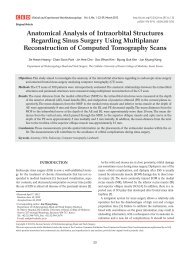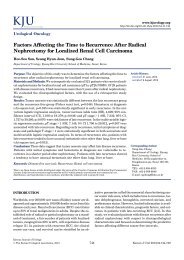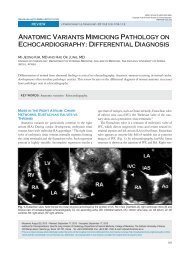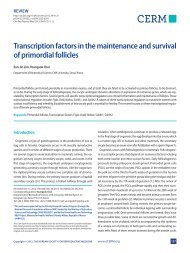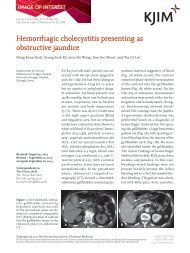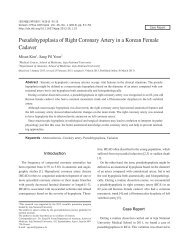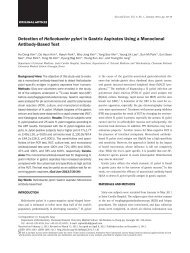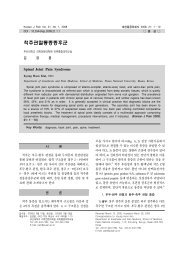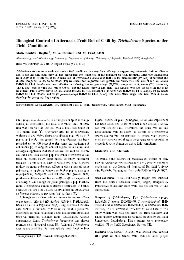Optimal Conditions for the Mycelial Growth of Coprinus comatus ...
Optimal Conditions for the Mycelial Growth of Coprinus comatus ...
Optimal Conditions for the Mycelial Growth of Coprinus comatus ...
You also want an ePaper? Increase the reach of your titles
YUMPU automatically turns print PDFs into web optimized ePapers that Google loves.
37(2) : 103-108 (2009)<br />
Mycobiology<br />
The Korean Society <strong>of</strong> Mycology<br />
©<br />
<strong>Optimal</strong> <strong>Conditions</strong> <strong>for</strong> <strong>the</strong> <strong>Mycelial</strong> <strong>Growth</strong> <strong>of</strong> <strong>Coprinus</strong> <strong>comatus</strong> Strains<br />
Jang Myoung-Jun 1<br />
Yun-Hae Lee *, 1<br />
Jun-Jie Liu , 2<br />
Young-Cheol Ju and 1<br />
1<br />
Research Station, GARES, Gyeonggi Province Gwang-ju 464-870, Korea<br />
Mushroom<br />
2<br />
Edible Fungi Institute Liaoning Academy <strong>of</strong> Agricultural Sciences, 84 Dong Ling Road Shenyang, China<br />
(Received March 16, 2009. Accepted June 18, 2009)<br />
principal objective <strong>of</strong> this study was to acquire basic data regarding <strong>the</strong> mycelial growth characteristics <strong>for</strong> <strong>the</strong> artificial<br />
The<br />
<strong>of</strong> <strong>Coprinus</strong> <strong>comatus</strong>. 12 URP primers were employed to evaluate <strong>the</strong> genetic relationships <strong>of</strong> C. <strong>comatus</strong>, and<br />
cultivation<br />
results were divided into three groups. Among six kinds <strong>of</strong> mushroom media, MYP medium was selected as <strong>the</strong> most<br />
<strong>the</strong><br />
culture medium <strong>for</strong> C. <strong>comatus</strong>. The optimal temperature and pH ranges <strong>for</strong> <strong>the</strong> mycelial growth <strong>of</strong> C. <strong>comatus</strong><br />
favorable<br />
23~26 were o<br />
and pH 6~8, respectively. The carbon and nitrogen sources <strong>for</strong> optimal mycelial growth were sucrose and<br />
C<br />
respectively.<br />
tryptone,<br />
KEYWORD : <strong>Coprinus</strong> <strong>comatus</strong>, Cultural characteristics, <strong>Mycelial</strong> growth, RAPD<br />
<strong>comatus</strong> is a member <strong>of</strong> <strong>the</strong> Agaricales family.<br />
<strong>Coprinus</strong><br />
Agaricales is a common fungus frequently seen on<br />
The<br />
along gravel roads, and in waste areas all over <strong>the</strong><br />
lawns,<br />
(Park and Lee, 2005). As <strong>the</strong>y age, <strong>the</strong>y deliquesce-<br />
world<br />
auto-digest <strong>the</strong>mselves--from <strong>the</strong> bottom <strong>of</strong> <strong>the</strong> cap<br />
-i.e.<br />
eventually turning into black ink. Sporophores<br />
upwards,<br />
digestion, and have been utilized <strong>for</strong> <strong>the</strong> treatment <strong>of</strong><br />
aid<br />
Its inhibition rates against Sarcoma 180 and Ehrlich<br />
piles.<br />
have been reported as 100% and 90%, respec-<br />
carcinoma<br />
(Ying et al., 1987). C. <strong>comatus</strong> has been identified<br />
tively<br />
containing ‘superior’(1 → 3)-β-glucan contents (Yang<br />
as<br />
al., 2003), and were determined to harbor ergothion-<br />
et<br />
a thiol compound with antioxidant properties (List,<br />
eine,<br />
The expected anti-oxidant activity was later con-<br />
1957).<br />
(Badalyan et al., 2003). Additionally, C. <strong>comatus</strong><br />
firmed<br />
been shown to harbor compounds that kill nematodes<br />
has<br />
and Xiang, 2005), and <strong>the</strong> mushroom is a delicious<br />
(Li<br />
nutritious agaric (Luo et al., 1991) that has been des-<br />
and<br />
as natural, nutritious, and healthy by both <strong>the</strong><br />
ignated<br />
and Agriculture Organization and <strong>the</strong> World Health<br />
Food<br />
Fig. 1. Fruit-body <strong>of</strong> Copinus <strong>comatus</strong>.<br />
*Corresponding author <br />
103<br />
(Liu and Zhang, 2003). 13 varieties <strong>of</strong> C.<br />
Organization<br />
were previously reported in a catalog <strong>of</strong> books in<br />
<strong>comatus</strong><br />
and <strong>the</strong> optimal growth temperature has been<br />
China,<br />
as 25 reported o<br />
(Zhou, 2007). Additionally, many farm-<br />
C<br />
in China cultivate C. <strong>comatus</strong>, which is also referred<br />
ers<br />
by names such as “shaggy ink cap”, “lawyer’s wig”,<br />
to<br />
“shaggy mane” (Chen, 2000). Dong et al. (2006) pre-<br />
and<br />
reported that <strong>the</strong> optimal liquid medium composiviously<br />
<strong>of</strong> C. <strong>comatus</strong> was (adjusted to pH 8.0): sucrose 3%,<br />
tion<br />
powder 2%, wheat bran 4%, KH2PO4 0.1% and<br />
corn<br />
4·7H2O 0.05%. Additionally, methods <strong>for</strong> its cultiva-<br />
MgSO<br />
include bag cultures (Luo and Qian, 1999; Zhu,<br />
tion<br />
and bed cultures (Zhu, 1998), and <strong>the</strong> substrates<br />
1998)<br />
<strong>for</strong> its cultivation include cotton waste, corn cobs,<br />
used<br />
straw, urea, ox manure, lime, etc. (Yang and Xue,<br />
rice<br />
Recently, ef<strong>for</strong>ts to improve <strong>the</strong> cultivation tech-<br />
2000).<br />
<strong>for</strong> our farm and automated facilities have resulted<br />
niques<br />
an increase in total mushroom production; 55,274 M/T<br />
in<br />
1990, and 146,346 M/T in 2007 (Ministry <strong>for</strong> Food,<br />
in<br />
Forestry and Fisheries in Korea, 2007). How-<br />
Agriculture,
104 Jang et al.<br />
only about 10 species <strong>of</strong> mushrooms are currently<br />
ever,<br />
on a large scale in Korea. There<strong>for</strong>e, we should<br />
cultivated<br />
new revenues by assessing <strong>the</strong> adaptability <strong>of</strong><br />
develop<br />
that are cultivated in China, and use <strong>the</strong><br />
mushrooms<br />
as a foundation <strong>for</strong> <strong>the</strong> enhancement <strong>of</strong> interna-<br />
results<br />
competitiveness in <strong>the</strong> mushroom industry.<br />
tional<br />
Materials and Methods<br />
and RAPD analysis. We previously collected a<br />
Strains<br />
<strong>of</strong> 7 varieties <strong>of</strong> C. <strong>comatus</strong> at <strong>the</strong> Edible Fungi<br />
total<br />
Liaoning Academy <strong>of</strong> Agricultural Sciences,<br />
Institute,<br />
1996 to 2006; <strong>the</strong> mycelia <strong>of</strong> each isolate were<br />
from<br />
on PDA. For RAPD analysis, we per<strong>for</strong>med a<br />
grown<br />
culture <strong>of</strong> <strong>the</strong> mycelia into PDB, and <strong>the</strong>n eradi-<br />
static<br />
<strong>the</strong> media by vacuum culturing <strong>the</strong> mycelium on<br />
cated<br />
No. 2 filter paper, pouring liquid nitrogen into<br />
Whatman<br />
sample after lyophilization, and pulverizing it. We<br />
<strong>the</strong><br />
added 1 ml <strong>of</strong> nucleic lysis buffer and 10 µl <strong>of</strong> pro-<br />
<strong>the</strong>n<br />
K (25 mg/ml) into 0.2 g <strong>of</strong> pulverized. Mycelium,<br />
teinase<br />
allowed <strong>the</strong> reaction to proceed <strong>for</strong> 1 hour at 60 and o<br />
C<br />
2~3 minutes <strong>of</strong> vortexing, and <strong>the</strong>n divided it into<br />
after<br />
1.5 ml microtubes to generate 250 µl supernatants<br />
four<br />
10 minutes <strong>of</strong> centrifugation at 14,000 rpm. We col-<br />
after<br />
<strong>the</strong> supernatants from <strong>the</strong> columns after centrifugalected<br />
at 14,000 rpm on repeat <strong>for</strong> 4 1-minute cycles in a<br />
tion<br />
column after mixing 500 µl <strong>of</strong> DNA binding buffer<br />
spin<br />
<strong>the</strong> sample. Then, in sequential order, we rinsed <strong>the</strong><br />
with<br />
with 800 µl <strong>of</strong> 75% ethanol, applied 1 minute <strong>of</strong><br />
sample<br />
at 14,000 rpm, rinsed again with 300 µl <strong>of</strong><br />
centrifugation<br />
ethanol, applied 1 additional minute <strong>of</strong> centrifuga-<br />
75%<br />
at 14,000 rpm, 2 more minutes at 14,000 rpm after<br />
tion<br />
addition <strong>of</strong> 100 µl <strong>of</strong> elution buffer, and finally<br />
<strong>the</strong><br />
<strong>the</strong> DNA concentration via electrophoresis. 12<br />
assessed<br />
<strong>of</strong> primer were utilized, and PCR was conducted as<br />
types<br />
preheating at 94 follows: o<br />
<strong>for</strong> 5 minutes, denaturation at<br />
C<br />
94 o<br />
<strong>for</strong> 1 minute, annealing at 55 C o<br />
<strong>for</strong> 1 minute, exten-<br />
C<br />
Table 1. The composition <strong>of</strong> used media<br />
Ingredients<br />
at 72 sion o<br />
<strong>for</strong> 2 minutes and maintenance at 4 C o<br />
after a C<br />
extension step at 72 final o<br />
C <strong>for</strong> 2 minutes after a total <strong>of</strong><br />
cycles. The amplified fragments were <strong>the</strong>n electro-<br />
35<br />
at 100 V in 1.8% agarose gel, dyed <strong>for</strong> 10 minutes<br />
phoresed<br />
EtBr (ethidium bromide) and investigated <strong>for</strong> bands<br />
with<br />
a UV transilluminator lamp. We conducted cluster<br />
using<br />
via UPGMA (unweighted paired group methods<br />
analysis<br />
arithmetic average) <strong>for</strong> RAPD analysis.<br />
with<br />
<strong>of</strong> favorable culture media. Six different cul-<br />
Selection<br />
media were utilized to assess <strong>the</strong> mycelial growth <strong>of</strong><br />
ture<br />
<strong>comatus</strong> (Table 1). The media were adjusted to pH 6<br />
C.<br />
to <strong>the</strong> autoclaving process. After autoclaving (1.5<br />
prior<br />
kg/cm 2<br />
<strong>for</strong> 15 minutes at 121 ) o<br />
20 ml <strong>of</strong> each medium<br />
C,<br />
poured aseptically into a petri dish. A 5 mm cork<br />
was<br />
<strong>of</strong> <strong>the</strong> inoculum was removed from a 10-day-old<br />
borer<br />
<strong>of</strong> C. <strong>comatus</strong> grown on PDA, and placed in <strong>the</strong><br />
culture<br />
<strong>of</strong> agar plates, each containing one <strong>of</strong> six different<br />
centre<br />
media. After 9 days <strong>of</strong> incubation at 25 ± 1 culture o<br />
<strong>the</strong> C,<br />
growth <strong>of</strong> C. <strong>comatus</strong> was evaluated.<br />
mycelial<br />
<strong>of</strong> temperature <strong>for</strong> mycelial growth. In order to<br />
Effect<br />
<strong>the</strong> ideal temperature <strong>for</strong> <strong>the</strong> mycelial growth <strong>of</strong><br />
determine<br />
<strong>comatus</strong>, 6 different temperatures (17, 20, 23, 26, 29 and<br />
C.<br />
32 o<br />
were adopted. A 5 mm diameter agar plug was<br />
C)<br />
from 10-day-old cultures grown on PDA and posi-<br />
removed<br />
in <strong>the</strong> centers <strong>of</strong> agar plates, each filled with 20 ml <strong>of</strong><br />
tioned<br />
After 9 days <strong>of</strong> incubation at 6 different temperatures,<br />
PDA.<br />
mycelial growth <strong>of</strong> C. <strong>comatus</strong> was evaluated.<br />
<strong>the</strong><br />
<strong>of</strong> pH <strong>for</strong> mycelial growth. A 5 mm diameter<br />
Effect<br />
plug was removed from 10-day-old cultures grown<br />
agar<br />
PDA, <strong>the</strong>n added to 250 ml Erlenmeyer flasks filled<br />
on<br />
100 ml <strong>of</strong> PDB. The medium was adjusted to pH<br />
with<br />
<strong>of</strong> 4, 5, 6, 7 and 8 with <strong>the</strong> addition <strong>of</strong> 0.1 N-<br />
values<br />
or 0.1 N-HCl and incubated <strong>for</strong> 14 days at 25 NaOH o<br />
C,<br />
125 rpm after inoculation. We filtered <strong>the</strong> liquid with fil-<br />
Concentration (g/l)<br />
PDA MEA MCM Czapek-Dox GPYM MYP<br />
dextrose 24<br />
Potato<br />
20 20 30<br />
Dextrose<br />
10<br />
Glucose<br />
1 2 10 5<br />
Peptone<br />
extract 20 15 3<br />
Malt<br />
extract 2 10 3<br />
Yeast<br />
2HPO4 1 1<br />
K<br />
2PO4 0.46<br />
KH<br />
4·7H2O 0.5 0.5<br />
MgSO<br />
3<br />
2<br />
NaNO<br />
0.5<br />
KCl<br />
2SO4·7H2O 0.01<br />
Fe<br />
Agar 20 20 20 20 20 20
<strong>Optimal</strong> <strong>Conditions</strong> <strong>for</strong> <strong>the</strong> <strong>Mycelial</strong> <strong>Growth</strong> <strong>of</strong> <strong>Coprinus</strong> <strong>comatus</strong> Strains 105<br />
paper (Whatman No.2) and air-dried <strong>the</strong> samples at<br />
ter<br />
50 o<br />
<strong>for</strong> 48 hours <strong>for</strong> dry weight measurements <strong>of</strong> <strong>the</strong><br />
C<br />
mycelial samples after 14 days.<br />
<strong>of</strong> carbon and nitrogen sources <strong>for</strong> mycelial<br />
Effect<br />
The mycelial growth <strong>of</strong> C. <strong>comatus</strong> was assessed<br />
growth.<br />
each <strong>of</strong> <strong>the</strong> basal media supplemented with 10 carbon<br />
on<br />
eight nitrogen sources, respectively. The basal media<br />
and<br />
carbon source selection were composed <strong>of</strong> 11 carbon<br />
<strong>for</strong><br />
(30 g), tryptone (1 g), MgSO 4·7H2O (5.0 g), KCl<br />
sources<br />
g), FeSO4·7H2O (0.1 g), KH2PO4 (1.0 g), agar (20 g),<br />
(0.5<br />
distilled water (1000 ml). The basal media <strong>for</strong> nitro-<br />
and<br />
source selection were composed <strong>of</strong> 8 nitrogen sources<br />
gen<br />
g), sucrose (30 g), MgSO4·7H2O (5.0 g), KCl (0.5 g),<br />
(30<br />
4·7H2O (0.1 g), KH2PO4 (1.0 g), agar (20 g), and dis-<br />
FeSO<br />
water (1000 ml). In both cases, <strong>the</strong> basal medium was<br />
tilled<br />
to pH 6 and autoclaved <strong>for</strong> 15 minutes on 121 adjusted o<br />
C<br />
plates. The inoculated dishes were replicated four<br />
poured<br />
and incubated <strong>for</strong> 14 days at 25 times o<br />
in darkness. Myce-<br />
C<br />
lial growth was measured as previously described.<br />
Results and Discussion<br />
analysis. PCR band phase was analyzed with 12<br />
RAPD<br />
primers (Fig. 2), and resulted in seven varieties <strong>of</strong><br />
URP<br />
2. Random amplified polymorphic DNA patterns by primer<br />
Fig.<br />
URP5 and URP11. M: 1 kb ladder; lane 1,<br />
URP3,<br />
lane 2, GMCC54003; lane 3,<br />
GMCC54002;<br />
lane 4, GMCC67001; lane 5,<br />
GMCC54004;<br />
lane 6, GMCC67003; lane 7,<br />
GMCC67002;<br />
GMCC67004.<br />
Table 2. Effect <strong>of</strong> media on mycelial growth <strong>of</strong> C. <strong>comatus</strong> strains<br />
GMCC strain<br />
bands at URP 3; in particular, <strong>the</strong> URP 5 and 11<br />
different<br />
tended to stain similarly, which is characteristic <strong>of</strong><br />
primers<br />
among equal groups. The RAPD analysis<br />
intraspecificity<br />
<strong>the</strong> collected varieties was divided into 3 groups<br />
<strong>of</strong><br />
to <strong>the</strong> results <strong>of</strong> <strong>the</strong> band phases <strong>of</strong> URP 3, 5<br />
according<br />
11; however, we noted no morphological differences<br />
and<br />
among strains (Fig. 3).<br />
<strong>of</strong> favorable culture media. Six different cul-<br />
Selection<br />
media were utilized to determine <strong>the</strong> optimal myceture<br />
growth <strong>of</strong> seven different strains <strong>of</strong> C. <strong>comatus</strong>.<br />
lial<br />
<strong>the</strong> 6 culture media utilized, MYP medium was<br />
Among<br />
to be exceedingly favorable in promoting <strong>the</strong><br />
shown<br />
growth <strong>of</strong> C. <strong>comatus</strong>, whereas Czapek-Dox<br />
mycelial<br />
per<strong>for</strong>med extremely poorly; additionally, among<br />
medium<br />
variants <strong>of</strong> C. <strong>comatus</strong>, GMCC 54001 evidenced <strong>the</strong><br />
7<br />
levels <strong>of</strong> mycelial growth length on MCM medium<br />
highest<br />
2). Chaiyma et al. (2007) previously reported<br />
(Table<br />
mycelial growth <strong>of</strong> C. <strong>comatus</strong> cultivated on<br />
favorable<br />
extract agar. However, Chaiyma et al. (2007) did not<br />
Malt<br />
use <strong>of</strong> MYP in his experiments. There<strong>for</strong>e, we con-<br />
make<br />
that MYP was <strong>the</strong> optimal medium <strong>for</strong> <strong>the</strong> mycecluded <br />
lial growth <strong>of</strong> C. <strong>comatus</strong>.<br />
3. Grouping <strong>of</strong> C. <strong>comatus</strong> strains by URP 3, URP 5 and<br />
Fig.<br />
11 primers. The numbers above each branch<br />
URP<br />
<strong>the</strong> coefficient value. The right number<br />
indicate<br />
<strong>the</strong> strain number.<br />
indicates<br />
<strong>Mycelial</strong> growth (mm/9 days)<br />
PDA MEA MCM Czapek-Dox GPYM MYP<br />
46 ± 2.6 59 ± 1.2 81 ± 1.2 22 ± 2.5 53 ± 3.8 75 ± 00.<br />
54001<br />
50 ± 00. 60 ± 2.0 67 ± 1.5 22 ± 2.0 49 ± 1.2 76 ± 1.7<br />
54002<br />
50 ± 5.0 55 ± 3.0 67 ± 2.1 13 ± 4.2 51 ± 0.6 74 ± 1.7<br />
54003<br />
62 ± 2.6 66 ± 1.2 73 ± 7.9 22 ± 2.1 53 ± 1.2 79 ± 1.2<br />
67001<br />
47 ± 4.4 52 ± 2.5 68 ± 1.5 22 ± 2.5 44 ± 1.7 72 ± 2.5<br />
67002<br />
43 ± 3.2 55 ± 2.0 67 ± 2.9 26 ± 4.6 47 ± 1.5 74 ± 1.2<br />
67003<br />
46 ± 3.8 53 ± 2.5 68 ± 2.9 23 ± 2.3 47 ± 3.6 77 ± 1.7<br />
67004<br />
Mean a<br />
SD 49d ± 6.1 57c ± 4.8 70b ± 5.4 22e ± 4.0 49d ± 3.3 75a ± 2.3<br />
±<br />
a<br />
followed by <strong>the</strong> same letter do not differ significantly at p > 0.05 according to Duncan's multiple range test.<br />
Values
106 Jang et al.<br />
Table 3. Effect <strong>of</strong> temperature on mycelial growth <strong>of</strong> C. <strong>comatus</strong> strains<br />
GMCC strain<br />
<strong>of</strong> temperature on mycelial growth. The suit-<br />
Effect<br />
temperature <strong>for</strong> <strong>the</strong> mycelial growth <strong>of</strong> C. <strong>comatus</strong><br />
able<br />
observed at 23~26 was o<br />
and GMCC 67001 evidenced<br />
C<br />
highest levels <strong>of</strong> mycelial growth at 63 mm at 26 <strong>the</strong> o<br />
C<br />
3, Fig. 4). However, at temperatures above 29 (Table o<br />
or C<br />
20 below o<br />
seven strains <strong>of</strong> C. <strong>comatus</strong> evidenced poor<br />
C,<br />
growth. With regard to <strong>the</strong> optimal culture tem-<br />
mycelial<br />
range <strong>of</strong> C. <strong>comatus</strong>, Luo and Qian (1999) and<br />
perature<br />
(2001) reported it as 25~27 Kim o<br />
Yang and Xue (2000)<br />
C,<br />
24~28 as o<br />
and Shiyong and Zaipei (2007) as 22~28 C o<br />
C.<br />
<strong>Mycelial</strong> growth(mm / 9days)<br />
17 o<br />
20 C o<br />
23 C o<br />
26 C o<br />
29 C o<br />
32 C o<br />
C<br />
23 ± 2.0 30 ± 5.0 54 ± 1.0 44 ± 6.0 35 ± 3.0 21 ± 1.0<br />
54001<br />
24 ± 2.5 29 ± 4.9 51 ± 2.8 47 ± 4.2 35 ± 3.0 27 ± 2.0<br />
54002<br />
19 ± 1.2 24 ± 3.0 43 ± 3.1 47 ± 3.8 30 ± 3.6 23 ± 2.1<br />
54003<br />
24 ± 3.2 32 ± 2.8 54 ± 2.0 63 ± 1.0 43 ± 5.0 35 ± 0.7<br />
67001<br />
16 ± 1.0 23 ± 1.5 45 ± 4.2 44 ± 2.1 34 ± 9.8 30 ± 0.7<br />
67002<br />
19 ± 1.2 25 ± 2.0 45 ± 3.5 56 ± 3.5 32 ± 4.2 27 ± 4.2<br />
67003<br />
18 ± 1.0 30 ± 2.6 55 ± 3.5 54 ± 2.1 46 ± 2.5 29 ± 4.0<br />
67004<br />
Mean a<br />
SD 20d ± 3.2 28c ± 3.4 49a ± 5.1 51a ± 7.2 36b ± 5.8 27c ± 4.4<br />
±<br />
a<br />
followed by <strong>the</strong> same letter do not differ significantly at p > 0.05 according to Duncan’s multiple range test.<br />
Values<br />
4. Configuration on mycelial growth <strong>of</strong> Copinus <strong>comatus</strong><br />
Fig.<br />
incubated at 23 strains o<br />
<strong>for</strong> 9 days.<br />
C<br />
Table 4. Effect <strong>of</strong> pH on mycelial growth <strong>of</strong> C. <strong>comatus</strong> strains<br />
GMCC strain<br />
above results were consistent with <strong>the</strong> results <strong>of</strong> this<br />
The<br />
Consequently, we selected 26 study. o<br />
as <strong>the</strong> optimal<br />
C<br />
mycelial growth temperature <strong>of</strong> C. <strong>comatus</strong>.<br />
<strong>of</strong> pH <strong>for</strong> mycelial growth. Favorable mycelial<br />
Effect<br />
<strong>of</strong> C. <strong>comatus</strong> was observed in a pH range <strong>of</strong> 6~8<br />
growth<br />
4). Among <strong>the</strong> seven strains, <strong>the</strong> optimal mycelial<br />
(Table<br />
was noted at a pH <strong>of</strong> 7. GMCC 67002 and<br />
growth<br />
67004 had <strong>the</strong> highest mycelial dry weight at<br />
GMCC<br />
mm at a pH <strong>of</strong> 7. Since <strong>the</strong> mycelial growth <strong>of</strong> C.<br />
75<br />
was generally favorable in a pH range <strong>of</strong> 6.5~7.5<br />
<strong>comatus</strong><br />
and Yang, 2000; Shiyong and Zaipei, 2007). We<br />
(Chen<br />
<strong>the</strong> highest mycelial dry weight at pH 7. There-<br />
observed<br />
it can be seen that <strong>the</strong> results shown above are simi<strong>for</strong>e, <br />
lar with <strong>the</strong> results <strong>of</strong> <strong>the</strong> present study.<br />
<strong>of</strong> carbon and nitrogen sources <strong>for</strong> mycelial<br />
Effect<br />
The carbon sources that most effectively pro-<br />
growth.<br />
<strong>the</strong> mycelial growth <strong>of</strong> C. <strong>comatus</strong> were maltose<br />
moted<br />
sucrose in disaccharide, and starch in polysaccharide<br />
and<br />
5). Among <strong>the</strong> 10 carbon sources utilized herein,<br />
(Table<br />
67001 evidenced <strong>the</strong> highest mycelial growth<br />
GMCC<br />
mm) in sucrose. Chaiyama et al. (2007) identified <strong>the</strong><br />
(74<br />
culture carbon sources <strong>of</strong> C. <strong>comatus</strong> as mannose<br />
optimal<br />
maltose. However, we did not use mannose in this<br />
and<br />
So, <strong>the</strong> mycelial growth <strong>of</strong> C. <strong>comatus</strong> at<br />
experiment.<br />
Dry weight <strong>of</strong> mycelial (mg/14 days)<br />
pH 4 pH 5 pH 6 pH 7 pH 8<br />
55 ± 3.7 59 ± 5.3 069 ± 25.4 67 ± 8.9 65 ± 4.6<br />
54001<br />
60 ± 5.7 63 ± 1.4 64 ± 3.9 65 ± 9.2 64 ± 4.1<br />
54002<br />
60 ± 9.5 059 ± 13.0 063±11.2 65±3.6 62±2.4<br />
54003<br />
56 ± 5.1 65 ± 1.8 67 ± 5.1 69 ± 5.7 63 ± 7.1<br />
67001<br />
044 ± 14.8 047 ± 10.9 59 ± 5.7 75 ± 6.6 065±11.2<br />
67002<br />
56 ± 7.7 061 ± 11.1 64 ± 7.0 72 ± 6.5 059±11.1<br />
67003<br />
59 ± 6.7 61 ± 8.7 64 ± 3.2 75 ± 5.9 62 ± 6.7<br />
67004<br />
Mean a<br />
SD 56c ± 5.6 59bc ± 5.6 64b ± 3.2 70a ± 4.4 63b ± 2.1<br />
±<br />
a<br />
followed by <strong>the</strong> same letter do not differ signification at p > 0.05 according to Duncan’s multiple range test.<br />
Values
<strong>Optimal</strong> <strong>Conditions</strong> <strong>for</strong> <strong>the</strong> <strong>Mycelial</strong> <strong>Growth</strong> <strong>of</strong> <strong>Coprinus</strong> <strong>comatus</strong> Strains 107<br />
Table 5. Effect <strong>of</strong> carbon source on mycelial growth <strong>of</strong> C. <strong>comatus</strong> strains<br />
GMCC strain<br />
was comparatively good.<br />
amaltose<br />
nitrogen source that most effectively promoted <strong>the</strong><br />
The<br />
growth <strong>of</strong> C. <strong>comatus</strong> was tryptone in organic<br />
mycelial<br />
(Table 6). Among <strong>the</strong> eight nitrogen sources uti-<br />
nitrogen<br />
herein, GMCC 67002 evidenced optimal mycelial<br />
lized<br />
(72 mm) in tryptone. However, NaNO2 in mineral<br />
growth<br />
depressed <strong>the</strong> mycelial growth <strong>of</strong> C. <strong>comatus</strong>,<br />
nitrogen<br />
mycelial growth was weak in NaNO 3, NH4NO3, and<br />
and<br />
4Cl. Thus, on <strong>the</strong> basis <strong>of</strong> our results, we identified<br />
NH<br />
as <strong>the</strong> optimal nitrogen source <strong>for</strong> <strong>the</strong> mycelial<br />
tryptone<br />
growth <strong>of</strong> C. <strong>comatus</strong>.<br />
References<br />
Glu a<br />
Gal a<br />
Fru a<br />
C. M., Gasparyan, A. V. and Garibyan, N. G. 2003.<br />
Badalyan,<br />
<strong>of</strong> <strong>the</strong> antioxidant activity <strong>of</strong> some basidial mac-<br />
Investigation<br />
Mikol Fitopatol. 37:63-68.<br />
romycetes.<br />
V., Petcharat, V. and Kritsaneepaiboon, P. 2007. Some<br />
Chaiyama,<br />
and physiological aspects and cultivation <strong>of</strong><br />
morphological<br />
<strong>comatus</strong> (O.F.Mull.) Gray. Songklanakarin J. Sci.<br />
Copinus<br />
29:261-274.<br />
Technol.<br />
M. M. 2000. Cultivation techniques <strong>for</strong> Dictyophora, Poly-<br />
Chen,<br />
umbellata, Copinus <strong>comatus</strong>. Science and cultivation <strong>of</strong><br />
porus<br />
fungi. Mushroom Science 2:543-548.<br />
edible<br />
Z. Z. and Yang, J. 2000. The new century mushroom culti-<br />
Chen,<br />
using technology. People’s Liberation Army Publishing<br />
vation<br />
growth (mm/14 days)<br />
<strong>Mycelial</strong><br />
Xylo a<br />
Mal a<br />
Suc a<br />
Lac a<br />
48 ± 1.3 50 ± 1.3 39 ± 0.6 24 ± 0.7 54 ± 0.9 64 ± 1.7 22 ± 0.6 41 ± 0.7 43 ± 0.6 60 ± 1.6<br />
54001<br />
51 ± 3.0 49 ± 1.9 47 ± 0.7 27 ± 1.3 58 ± 1.5 65 ± 2.1 26 ± 1.2 54 ± 3.9 44 ± 2.4 62 ± 1.8<br />
54002<br />
52 ± 3.7 47 ± 0.8 42 ± 1.5 24 ± 4.1 63 ± 2.0 64 ± 0.2 22 ± 0.7 47 ± 2.2 48 ± 0.8 69 ± 3.3<br />
54003<br />
5 6± 1.6 54 ± 1.8 48 ± 1.2 30 ± 0.5 64 ± 1.0 74 ± 1.0 22 ± 0.5 50 ± 1.1 48 ± 1.5 72 ± 2.6<br />
67001<br />
54 ± 4.9 48 ± 2.0 46 ± 3.4 32 ± 1.2 66 ± 3.0 65 ± 0.7 26 ± 0.6 54 ± 4.7 45 ± 1.8 64 ± 2.4<br />
67002<br />
57 ± 3.9 48 ± 2.1 46 ± 2.4 32 ± 1.5 66 ± 1.3 71 ± 2.3 25 ± 0.5 49 ± 2.2 43 ± 1.8 62 ± 4.6<br />
67003<br />
52 ± 4.7 47 ± 0.8 46 ± 4.5 30 ± 0.9 61 ± 3.5 68 ± 1.3 28 ± 0.4 53 ± 3.3 43 ± 1.5 68 ± 0.8<br />
67004<br />
Mean b<br />
SD 53c ± 3.3 49c ± 2.4 45d ± 3.3 28e ± 3.6 62b ± 4.4 67a ± 3.9 24f ± 2.2 50c ± 4.5 45d ± 2.4 65ab± 4.6<br />
±<br />
a<br />
glucose, Gal: galactose, Fru: frutose, Xylo: xylose, Mal: maltose, Suc: sucrose, Lac: lactose, CM: CM-cellulose, Xyla: xylan, Sta: starch.<br />
Glu:<br />
b<br />
followed by <strong>the</strong> same letter do not differ significantly at p > 0.05 according to Duncan's multiple range test.<br />
Values<br />
Table 6. Effect <strong>of</strong> nitrogen source on mycelial growth <strong>of</strong> C. <strong>comatus</strong> strains<br />
GMCC strain<br />
<strong>Mycelial</strong> growth (mm/14 days) a<br />
NaNO 2 NaNO 3 NH 4NO 3 NH 4Cl peptone tryptone urea Yeast extract<br />
− 13 ± 0.5 10 ± 0 12 ± 2.0 55 ± 3.2 63 ± 0.9 51 ± 3.4 49 ± 1.0<br />
54001<br />
− 18 ± 0.7 13 ± 1.1 14 ± 1.3 64 ± 2.4 58 ± 2.5 56 ± 7.9 49 ± 1.0<br />
54002<br />
− 16 ± 3.0 11 ± 0.1 14 ± 1.6 67 ± 1.0 71 ± 0.6 49 ± 2.2 63 ± 1.1<br />
54003<br />
− 18 ± 1.0 12 ± 1.5 13 ± 0.4 66 ± 1.6 68 ± 1.1 46 ± 7.6 63 ± 1.3<br />
67001<br />
− 17 ± 1.4 13 ± 0.8 11 ± 0.7 66 ± 1.8 72 ± 1.4 62 ± 3.8 47 ± 5.5<br />
67002<br />
− 18 ± 0.4 14 ± 1.7 15 ± 4.3 23 ± 1.0 65 ± 1.7 57 ± 3.0 48 ± 2.5<br />
67003<br />
− 18 ± 1.6 14 ± 1.2 14 ± 2.7 23 ± 1.2 66 ± 2.7 59 ± 1.3 51 ± 3.4<br />
67004<br />
Mean b<br />
− 17c ± 1.7 12c ± 1.2 13c ± 1.3 52b ± 20.2 66a ± 4.5 54b ± 5.7 53b ± 7.0<br />
±SD<br />
a<br />
rate.<br />
<strong>Growth</strong><br />
b<br />
followed by <strong>the</strong> same letter do not differ significantly at p > 0.05 according to Duncan’s multiple range test.<br />
Values<br />
CM a<br />
Xyla a<br />
Sta a<br />
pp. 414-422.<br />
House.<br />
Y. H., Wang, H. Q. and Qiu, L. Y. 2006. Optimization <strong>of</strong> a<br />
Dong,<br />
growth medium <strong>for</strong> Copinus <strong>comatus</strong>. Acta Edulis<br />
liquid<br />
13:29-31.<br />
Fungi.<br />
Y. G. 2001. Studies on <strong>the</strong> morphology characteristics <strong>of</strong><br />
Kim,<br />
species and artificial cultivation <strong>of</strong> C. <strong>comatus</strong>. Mas-<br />
<strong>Coprinus</strong><br />
degree <strong>the</strong>sis. Chungnam National University, Korea.<br />
ter's<br />
Y. and Xiang, H. 2005. Nematicidal activity <strong>Coprinus</strong> coma-<br />
Li,<br />
Acta Phytopathologica Sinica. 35:456-458.<br />
tus.<br />
Y. F. and Zhang, J. S. 2003. Recent advances in <strong>the</strong> study on<br />
Liu,<br />
medicinal functions <strong>of</strong> <strong>Coprinus</strong> <strong>comatus</strong>. Acta Edible<br />
<strong>the</strong><br />
10:60-63.<br />
Fungi.<br />
P. H. 1957. Occurrence <strong>of</strong> ergothioneine in shaggy-mane.<br />
List,<br />
Pharm. Ber. Dtsch . Pharm. Ges. 290. 62:517-520.<br />
Arch.<br />
T. and Qian, Z. M. 1999. The key techniques <strong>of</strong> <strong>the</strong> CC100<br />
Luo,<br />
<strong>comatus</strong>. cultivation. Edible Fungi 4:14-15.<br />
Copinus<br />
X. Y., Lü, D. P. and Wang, W. 1991. Artifical culture <strong>of</strong><br />
Luo,<br />
<strong>comatus</strong> Kunyan C-901. Edible Fungi <strong>of</strong> China. 10:<br />
<strong>Coprinus</strong><br />
13-15.<br />
<strong>of</strong> writer. 2007. Ministry <strong>for</strong> Food, Agriculture, Forestry<br />
Name<br />
Fisheries in Korea. An actual output <strong>of</strong> a crop <strong>for</strong> a spe-<br />
and<br />
purpose. pp. 44-81.<br />
cial<br />
W. H. and Lee, H. D. 2005. Wild fungi <strong>of</strong> Korea. Kyo-Hak<br />
Park,<br />
Co., Ltd. pp. 218-219.<br />
Publishing<br />
J. and Zaipei, J. 2007. Mushroom cultivation tech-<br />
Shiyong,<br />
Chemical Industry Press, China. pp. 118-122.<br />
niques.<br />
G. L. and Xue, H. B. 2000. Specialized cultivation manual<br />
Yang,<br />
edible and medicinal mushroom. China Agricultural<br />
about
108 Jang et al.<br />
pp. 361-368.<br />
Press.<br />
X., Wan, M., Mi, K., Feng, H., Chan, D. K. O. and Yang,<br />
Yang,<br />
2003. The quantification <strong>of</strong> (1 → 3)-β-glucan in edible and<br />
Q.<br />
mushroom polysaccarides by using limulus G test.<br />
medicinal<br />
22:296-302.<br />
Mycosystema.<br />
J. Z., Mao, X. L., Ma, Q. M., Zong, Y. C. and Wen, H. A.<br />
Ying,<br />
Icons <strong>of</strong> medicinal fungi from China. Beijing. Science<br />
1987.<br />
pp. 313.<br />
Press.<br />
Y. G. 2007. China bacteria directory. Chemical Industry<br />
Zhou,<br />
pp. 522.<br />
Press.<br />
J. B. 1998. The cultivation techniques <strong>of</strong> Copinus <strong>comatus</strong><br />
Zhu,<br />
Shangai Nan-hui County. Edible Fungi. 3:32.<br />
on



